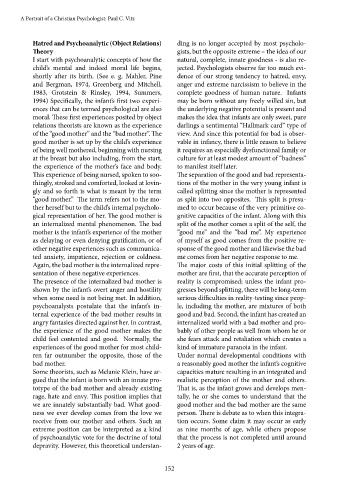Page 152 - EMCAPP-Journal No. 5
P. 152
A Portrait of a Christian Psychologist: Paul C. Vitz
Hatred and Psychoanalytic (Object Relations) ding is no longer accepted by most psycholo-
Theory gists, but the opposite extreme – the idea of our
I start with psychoanalytic concepts of how the natural, complete, innate goodness - is also re-
child’s mental and indeed moral life begins, jected. Psychologists observe far too much evi-
shortly after its birth. (See e. g. Mahler, Pine dence of our strong tendency to hatred, envy,
and Bergman, 1974, Greenberg and Mitchell, anger and extreme narcissism to believe in the
1983, Grotstein & Rinsley, 1994, Summers, complete goodness of human nature. Infants
1994) Specifically, the infant’s first two experi- may be born without any freely willed sin, but
ences that can be termed psychological are also the underlying negative potential is present and
moral. These first experiences posited by object makes the idea that infants are only sweet, pure
relations theorists are known as the experience darlings a sentimental “Hallmark card” type of
of the “good mother” and the “bad mother”. The view. And since this potential for bad is obser-
good mother is set up by the child’s experience vable in infancy, there is little reason to believe
of being well mothered, beginning with nursing it requires an especially dysfunctional family or
at the breast but also including, from the start, culture for at least modest amount of “badness”
the experience of the mother’s face and body. to manifest itself later.
This experience of being nursed, spoken to soo- The separation of the good and bad representa-
thingly, stroked and comforted, looked at lovin- tions of the mother in the very young infant is
gly and so forth is what is meant by the term called splitting since the mother is represented
“good mother.” The term refers not to the mo- as split into two opposites. This split is presu-
ther herself but to the child’s internal psycholo- med to occur because of the very primitive co-
gical representation of her. The good mother is gnitive capacities of the infant. Along with this
an internalized mental phenomenon. The bad split of the mother comes a split of the self, the
mother is the infant’s experience of the mother “good me” and the “bad me”. My experience
as delaying or even denying gratification, or of of myself as good comes from the positive re-
other negative experiences such as communica- sponse of the good mother and likewise the bad
ted anxiety, impatience, rejection or coldness. me comes from her negative response to me.
Again, the bad mother is the internalized repre- The major costs of this initial splitting of the
sentation of these negative experiences. mother are first, that the accurate perception of
The presence of the internalized bad mother is reality is compromised; unless the infant pro-
shown by the infant’s overt anger and hostility gresses beyond splitting, there will be long-term
when some need is not being met. In addition, serious difficulties in reality-testing since peop-
psychoanalysts postulate that the infant’s in- le, including the mother, are mixtures of both
ternal experience of the bad mother results in good and bad. Second, the infant has created an
angry fantasies directed against her. In contrast, internalized world with a bad mother and pro-
the experience of the good mother makes the bably of other people as well from whom he or
child feel contented and good. Normally, the she fears attack and retaliation which creates a
experiences of the good mother for most child- kind of immature paranoia in the infant.
ren far outnumber the opposite, those of the Under normal developmental conditions with
bad mother. a reasonably good mother the infant’s cognitive
Some theorists, such as Melanie Klein, have ar- capacities mature resulting in an integrated and
gued that the infant is born with an innate pro- realistic perception of the mother and others.
totype of the bad mother and already existing That is, as the infant grows and develops men-
rage, hate and envy. This position implies that tally, he or she comes to understand that the
we are innately substantially bad. What good- good mother and the bad mother are the same
ness we ever develop comes from the love we person. There is debate as to when this integra-
receive from our mother and others. Such an tion occurs. Some claim it may occur as early
extreme position can be interpreted as a kind as nine months of age, while others propose
of psychoanalytic vote for the doctrine of total that the process is not completed until around
depravity. However, this theoretical understan- 2 years of age.
152

